
views
Prewriting Your Statement

Think about your target audience. Who are you targeting with this product description? That's a vital question to ask. If your potential buyers identify with a particular group or culture, they're more likely to buy a product that also identifies with that group or culture. Think about who you're trying to target with your product description. Common characteristics to consider when trying to determine the target audience include age, gender, income level, buying habits, occupation, marital status, family status, location, education level, ethnic group, political affiliations, hobbies, and interests. If the company for which you are writing the description has an online presence, there are tools you can use to identify their demographic, such as Google Analytics. This can help you gather information on the type of person who frequents the company's website. The company sales team may also be able to provide you with this information. Say you're selling a new brand of flavored coffee for a local shop. The kinds of consumers who crave flavored coffee might be professionals or family-oriented people who prioritize taste over coffee purity or origin. Try to connect your coffee to the target customer's lifestyle. Business people will relate to someone enjoying a coffee before a busy day of work or as a break. Family-oriented people will respond to descriptions of someone enjoying coffee with their spouse or as their children get ready for school.

Connect the product's features to its benefits. Consumers generally go for products that provide them specific benefits. When writing a product description, ask yourself, "What would a customer gain from my product?" Ultimately, consumers want to buy something that has an inherent benefit to them. Make a list of the features of your product. From there, try to link these features to a benefit for customers. This will help you get a sense of what to focus on as you write your description. For the coffee example, try connecting the coffee's origin, tasting notes, caffeine content, or another quality of the coffee to its benefits (good flavor, a pleasant drinking experience, caffeine boost, feeling of helping a community/farmers, etc.). Find a way to stress your product's exceptional flavor. Why specifically is your ideal customer seeking flavored coffee? What's wrong with existing flavored and unflavored coffees?
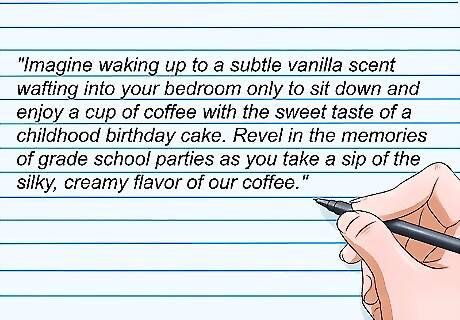
Jot down sensory images. Specifics are important when selling a product. If you can create sensory details, your readers will feel like they're experiencing the product secondhand. This may make them more likely to purchase it. Try to describe the experience of enjoying your product, using as many senses and images as possible. Returning to the flavored coffee example, try to imagine waking up to a pot of vanilla flavored coffee. What smells would you experience? What sights? How does the smell of a vanilla birthday cake make a person feel? You could write something like, "Imagine waking up to a subtle vanilla scent wafting into your bedroom, then sitting down to enjoy a cup of coffee with the sweet taste of a childhood birthday cake. Revel in the memories of grade school parties as you take a sip of the silky, creamy flavor of our coffee." Here, you create an experience for your reader. The reader imagines waking up, smelling coffee, tasting coffee, and having that coffee spark pleasant memories.
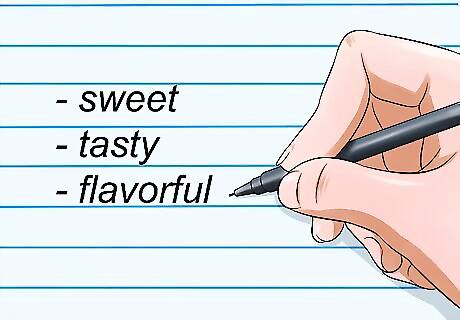
Make a list of descriptive words. You do not want to use average words to describe your product. Vivid language can really make your product sound great to potential buyers. Avoid neutral or common words when describing your product. To start brainstorming, make a list of words that remind you of your product and find ways to make these words pop. Imagine that the coffee from the previous example is flavored like birthday cake. The first words that may come to mind may be things like sweet, tasty, and flavorful. Are there any ways you can make those words more specific? What kind of cake does the coffee taste like? Maybe it has a vanilla flavor. Instead of using terms like "sweet" and "tasty," you could find something more specific. For example, you could say the coffee has a "silky, creamy vanilla flavor."
Writing the Statement
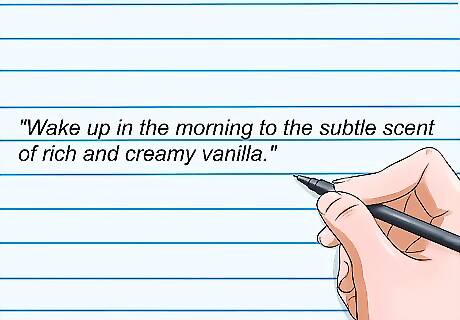
Start with a great opening. Consumers are bombarded with many ads every day. When writing a product description, you have a limited amount of time to get a consumer's attention. Use that time wisely. It is essential that you lead with a statement or question that grabs the reader's attention. Try appealing to the senses right away. In the coffee example, you could say something like, "Wake up in the morning to the subtle scent of rich and creamy vanilla." You can also ask your readers to imagine. For example, say something like, "Imagine there was a coffee that tasted as good as your favorite desserts." You can also try to appeal to the reader's identity initially. Try something like, "When you're drinking a cup of coffee, do you still get that same level of joy you felt when you started to drink coffee?"

Use the proper tone. Tone is important when it comes to product descriptions. Different readers will respond to different tones. As you write, make sure you adopt a tone appropriate for the audience at hand. Think about your company's brand. Are you trying to come off as cheeky, fun, and a little sarcastic to appeal to a certain audience? Or are you a more serious business trying to attract customers who are also quite serious? The tone of any coffee advertisement could be one of lighthearted enjoyment, describing the pleasure or life improvement brought by the flavor and caffeine in the coffee. However, a more serious coffee company could focus on bean quality, origin, having a high caffeine content, or being ready quickly for the busy professional.
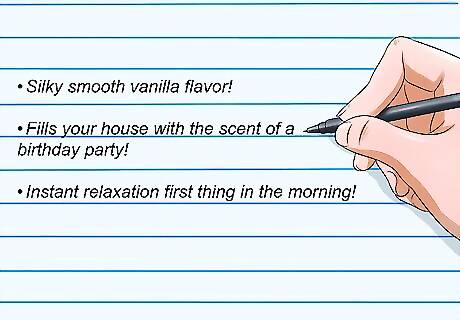
Cover the product quickly and vividly. Remember, you want to cover the product as fast as you can. Readers may scroll by if a product is long and wordy. Strive for a few brief and vivid sentences over lengthy descriptions. Things like bullet points can be particularly helpful, if you're able to use them. For example, instead of saying, "Our coffee has a smooth, creamy vanilla flavor that will make your house smell like a birthday party" you could break down these sentiments into a series of bullet points: "Silky smooth vanilla flavor!", "Fills your house with the scent of a birthday party!", "Instant relaxation first thing in the morning!"
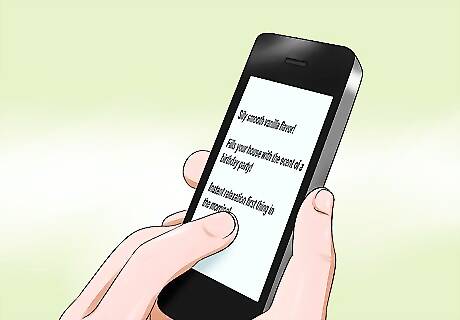
Keep length in mind. Many people read ads on a mobile phone these days. You want to make sure the bulk of your product description, if not all of it, will show up on a mobile phone screen. Short and simple is more memorable than long and complicated. You should also keep images in mind. If this description is being posted alongside an image, the image will take up space on the phone's screen as well. Do not just account for the text.
Revising Your Statement

Snip out stock phrases. You want to be unique in your description. Advertising is a competitive world and it's vital to stand out. As you read over the description you wrote, cut out any phrases that sound cliche. When you're reading your description, imagine how you would feel reading it as a consumer. If there are any phrases that make you think, "Yeah, yeah, that's what everyone says," these are phrases to cut out. Think of ways you can rewrite cliche or stock phrases to make them more unique to your product. For example, you may find a phrase like "high quality" in your description of your coffee. High quality is a largely meaningless term, as everyone wants buyers to believe their products are quality. What does high quality mean for this product and how can you convey that? For the coffee example, "high quality" would be best swapped out for words like, "organic" or "locally grown." These are the traits your target audience associates with quality.
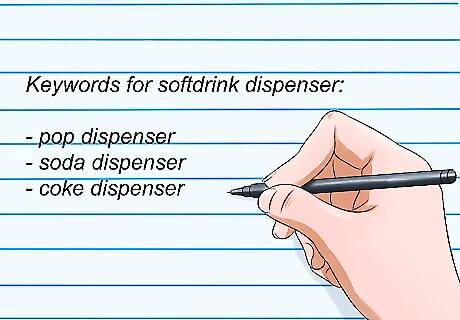
Add keywords. A good product description only works if it can reach readers. If your product is more likely to show up on a Google search engine, it's far more likely to sell. Make sure you use keywords that a consumer looking for this type of product will search for online. Do some research on search engine optimization (SEO) to ensure you are choosing keywords that will drive shoppers to your product. Keywords can sometimes be self-explanatory. If you're selling formal dress shoes, your customers will search for this; however, if you're selling an accessory to another product, keywords can be trickier. Think about what the product will be used for, and work that use into the description. For example, a wine rack should be called a "wine rack" specifically and not a "rack." Some products have different names. For example, soft drinks are referred to differently in different parts of the country. If you're selling a soft drink dispenser to be used in restaurants, you may want to add a small blurb on the bottom saying something like, "Also known as a pop dispenser, soda dispenser, or a coke dispenser." Do not overuse keywords, however, as this can make your description sound clunky.
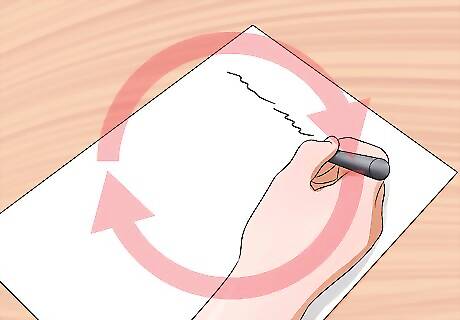
Rewrite the statement a few times. Revision is important when it comes to a product description. You'll want to write a few different drafts until you hit a statement that works. Play around with words and structure. Swap non-specific words for words that pack a bigger punch. You can also switch the order of sentences to make the ad read smoother. Get rid of unnecessarily long sentences by cutting out unneeded words. Have a friend or family member read over the statement. Ask them to give you an honest assessment of whether it makes them want to buy the product.

Proofread. You do not want to send a product description into the world if it contains errors. Before submitting your description, proofread carefully. Print out the statement as this makes it easier to catch errors. Take a break from the description for a day or so, as you'll be more likely to catch errors after gaining some space. Have a friend read over the description as well.














Comments
0 comment